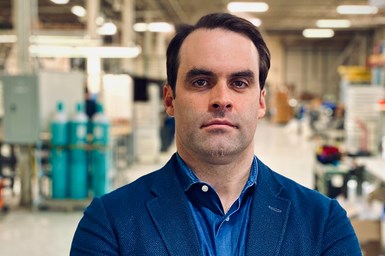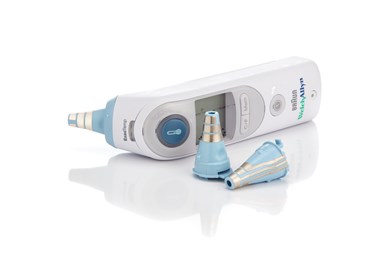A Conversation With Will Wallace of SAT Plating
SAT Plating general manager Will Wallace talks to Products Finishing about his company’s surface activation technology, plating on composites, and what the changing manufacturing landscape might mean for platers.

Will Wallace, general manager, SAT Plating
SAT Plating (Troy, Mich.) got its start in 2006 when general manager Will Wallace’s father and a group of engineers began work on a new surface treatment technology. At the time, the company was known as Surface Activation Technologies and was in the midst of research and development. After serving seven years in the Navy, Wallace joined the company in 2014 to support his father’s endeavor. Today SAT Plating specializes in electroplating high-performance plastics for such markets as aerospace, defense, space, medical, and automotive. Products Finishing recently sat down with Wallace to hear about the company’s unique focus.
PF: What makes SAT Plating different from other platers?
WW: We specialize in plating on polymers and composites — in particular, we commonly work with PEEK and Ultem. We do a lot with those materials in different forms — mostly injection molded, but also 3D printed/ additive manufactured components, and thin films as well. We’ve done a lot with PEEK film and plating in unique ways.
PF: How does your surface treatment technology work?
WW: It was initially developed to target plating on composites and particularly interconnect housings. With our Surface Activation process [Surface Activation is a registered trademark], we permanently and fundamentally change the surface of the polymer at the atomic level inside a controlled environment. There is no erosion of the surface or potential contaminants introduced — this is also not a plasma process. Surface Activation allows plating chemistry to bond with very strong adhesion. As with any surface finishing process — traditional metal plating, powder coating, painting — surface preparation is critical. This is where our treatment process sets us apart.
Our surface preparation of these engineered materials is very different from most traditional plating-on-plastic shops. Any experienced plater can plate a small volume of Ultem and PEEK parts by using such methods as media blasting, vibratory etching, acid cracking or swelling. These typically result in adequate adhesion, however these methods do not support a controlled and scalable process. In addition, they tend to be expensive and come with quality control challenges. The plating scrap rate is far too high. We want to be price competitive and deliver the performance advanced products require, all while handling high volumes and demonstrating outstanding quality control. We can process quantities into the millions. Many platers would likely not be comfortable with those volumes for a plating-on-plastic application, especially with PEEK and Ultem.
PF: What does your technology contribute to the properties of these materials?
WW: Aerospace, defense, automotive, and medical customers are typically coming to us for an electrical reason, specifically, EMI and RFI shielding. When you transition from machining a component out of aluminum and transfer that process to injection molding, you can quickly achieve economies of scale. However, our customers need metal characteristics on these molded parts, whether it’s corrosion resistance, or electromagnetic shielding. Typically, it’s a combination of both.
From SAT’s perspective, aircraft and vehicle components are getting smaller and lighter, with tighter packaging for electronics, all while having equivalent or more demanding performance requirements. Electric vehicles are a good example. These platforms are essentially satellites on wheels — there are GPS, RADAR, LiDAR, and RF systems throughout. With so many opportunities for signal interference, OEMs are realizing the criticality of shielding.

Photo Credit: SAT Plating
PF: Describe an example of work that SAT Plating does in the medical sector.
WW: One of our big projects is the plating of the Welch Allyn Pro 6000 — specifically the temperature probe tip which is combined with an IR sensor. This speculum is a two-shot injection molded part and our plating delivers a capacitive circuit at the surface. Our Surface Activation technology was critical in getting the plating to work and meet tight performance requirements. The molding and plating process really come together to deliver the end performance that is required. This much technical functionality in the speculum tip would not have been possible without sophisticated injection molding and a controlled plating process.
PF: Looking at some of the materials you are plating and the industries you work in, I’d like to hear your take on where the future is headed from a materials perspective.
WW: Automotive is a great example. That industry is clearly going to experience significant change in the coming years. Electric vehicles have a fraction of the components in their simplified systems and that affects various industries in the supply chain. It’s going to affect the platers — I imagine an EV will not require as many plated fastners as today’s internal combustion engine, for example.
Platers need to be prepared for this shift. As for plating on plastics, how can plating leverage the benefits of using high-performance plastics? How creative are your masking solutions? Can you optimize your plating process to pass the testing requirements that continually evolve?
From what I’ve seen during my involvement with automotive and aerospace, the quality standards are starting to line up. Aerospace has taken a lot of cues from the automotive supply chain systems and automotive looks to aerospace to see what they do. The reliability and quality control must be outstanding. I think it’s important for platers to make quality control a top priority.
Plating on plastics requires attention to detail and it helps to have technologies and capabilities that set you apart. For example, masking and selective plating. Sometimes certain components cannot have plating on the entire part. Instead, the customer only needs plating in certain areas which requires you to think outside the box. Can you optimize a masking and plating process that is controlled and can handle high-volume demands? This can be challenging, especially when there are firm cost targets.
Back to automotive. There is the legacy mindset of the supply chain and how vehicles are manufactured. How that approach evolves will be significant. I think about how few components future vehicles will need and how industries adapt to deliver value. There will be a lot of technical functionality in these vehicles — much of it on the electronics side — and how everything will work together will be interesting. One thing is for sure, the finishing industry needs to innovate and deliver solutions.
Related Content
Finishing High Reliability, Function Critical Parts
From safety critical automotive and aerospace components to lifesaving medical micro-components and implantable devices, Indiana-based Electro-Spec finishes applications that require zero failure rates.
Read MoreTop Shop’s Journey to Building a Unique Brand
Since this new Ohio plater took over the space and assets of a former plating business, it is intentional about setting itself apart from prior ownership.
Read MoreAdvancing Aerospace Connectors
OEMs looking to optimize aircraft performance and range are turning to composites and plastics, which require specific finishing treatments.
Read MorePPG, Satys Partner for Aerospace Ecoat System in France
PPG is partnering with Satys, a French industrial group active in aircraft sealing, painting and surface treatment.
Read MoreRead Next
Brush Plating with Metal Matrix Composites
Hard chrome has been used in the plating industry for decades, but due to the environmental and health risks associated with chromium compounds, there’s a call for change. Josh Thomas, electrochemist at SIFCO ASC discusses brush plating and metal matrix composites (MMC), a new generation of electroplating solutions.
Read MorePolamer Precision Incorporates Selective Plating Into Production Line
Global aerospace manufacturing company Polamer Precision, has worked with SIFCO ASC to bring a selective plating process in-house for improved output, lead time and quality control.
Read MoreA ‘Clean’ Agenda Offers Unique Presentations in Chicago
The 2024 Parts Cleaning Conference, co-located with the International Manufacturing Technology Show, includes presentations by several speakers who are new to the conference and topics that have not been covered in past editions of this event.
Read More






















